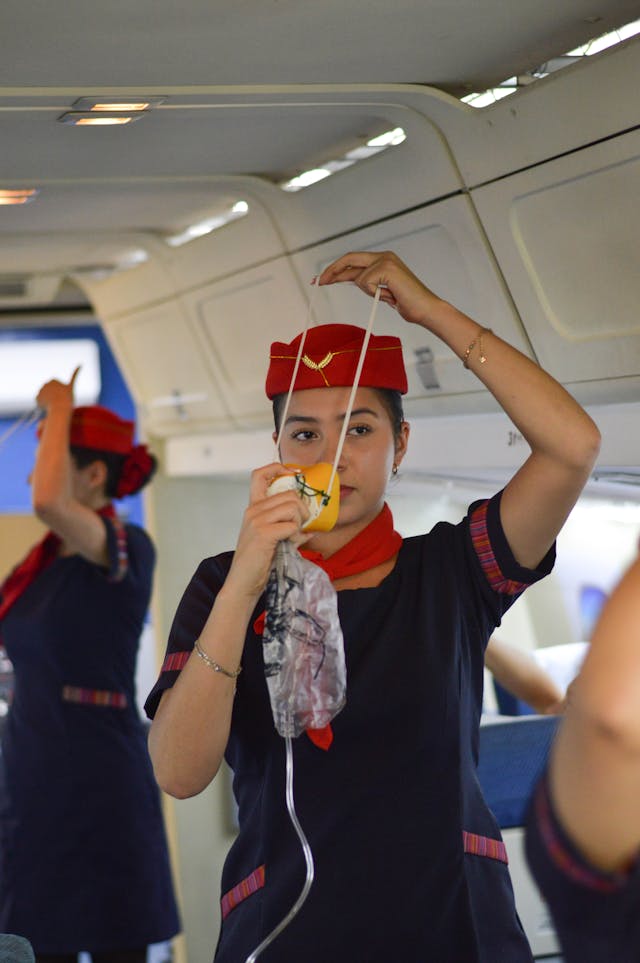
How do oxygen masks on a plane work? Oxygen masks on a plane work by initiating a chemical reaction that produces a relatively small supply of oxygen.
Hopefully, you will never have to experience the oxygen masks dropping down while you are on a plane. Flying on a plane is still statistically the safest way to travel, and the vast majority of plane crashes (over 97%) have no, or very few fatalities. The only reason we think flying is dangerous is that if a plane does crash with a lot of fatalities, the world’s media picks it up, and we all hear about it. Still, if you are on a plane and the oxygen masks drop, it doesn’t necessarily mean the plane is crashing. There are numerous reasons why the masks might drop down.
The most obvious reason that the masks will come down is because of decompression. Air pressure decreases with altitude, but it decreases more the higher you get. This is because the weight of the atmosphere pushing down increases the pressure at sea level. As you get higher, there is less and less weight above you, so the pressure decreases exponentially. At sea level, we have an air pressure of one atmosphere, or 1.03 kg/cm3. At the height of a commercial airliner, roughly 12,000 m, the pressure is 19% of that at sea level, or 0.191 kg/cm3. To keep us healthy and able to function, airplanes are generally pressurized to the air pressure at about 3,000 m, which is 71% that at sea level. This is perfectly fine, unless you happen to get a small hole in the plane. Air always wants to move from an area of high pressure to an area of low pressure, and if you have a hole in the plane, all of the air inside the plane will suddenly want to be outside of the plane. The force of all that air leaving can cause an explosive decompression.
Because the air pressure decreases, it means the concentration of oxygen in the air also decreases as well. The air we breathe is made up of 78% nitrogen, 21% oxygen, a little less than 1% argon, and other gases. All of these gases are still present in the same percentages, but they are spread out a lot more because of the low pressure atmosphere. If you are high up, you will not be able to get the same volume of oxygen with every breath that you would be able to get at sea level. That is why the top of Mt. Everest is so dangerous and why you wouldn’t be able to survive on the outside of an airplane. We can breathe inside the plane because we are breathing the air from outside the plane, but compressed. The plane’s engines compress all of the air coming in, which means we can breathe as though we were at 3,000 m.
If there is an explosive decompression, the rapidly decreasing pressure in the plane will trigger the oxygen masks to drop from the ceiling over your seat. There is a sensor that monitors the internal pressure of the plane and if that pressure drops to below the pressure you would get at 4,200 m, it will trigger the masks. The pilots can also trigger the masks manually, but they usually don’t need to. If the masks do come down, you need to put it on quickly because a human can only stay conscious for about 15 seconds with the oxygen available at 12,000 m. The brain needs a constant supply of oxygen and shuts down without it. That is why the instruction with the oxygen masks is always to put your own mask on before helping children. If your child passes out and you get the oxygen mask on them, they will wake up. If you pass out while helping your child, they won’t be able to put on your mask, and you will probably die.
When you put the oxygen mask on, the instruction is to pull it sharply down. This is because the mask is not connected to an oxygen tank, or a central oxygen supply. Above each seat is something called an oxygen candle. This is a cylinder made of sodium chlorate and iron powder. It has an ignitor at the base and is wrapped in thermal insulation. When you pull your mask down, it pulls a pin out that releases an ignition cap. This lights the base of the candle, which begins to burn. The candle burns at over 600℃. When exposed to heat, the two chemicals react to produce sodium chloride, iron oxide, and oxygen. The oxygen comes down through the tube into the oxygen mask. The flow of oxygen cannot be regulated, so there is a bag that collects the oxygen so we don’t breathe too much. The candle will burn out in about 15 minutes, which is usually plenty of time for the plane to make an emergency descent to a lower altitude. The pilots usually have oxygen masks that are connected to oxygen tanks. This is because they might need more oxygen than the system can generate, and there might be a problem with the internal oxygen system. And this is what I learned today.
Sources
https://en.wikipedia.org/wiki/Emergency_oxygen_system
https://en.wikipedia.org/wiki/Chemical_oxygen_generator
https://www.engineeringtoolbox.com/air-altitude-pressure-d_462.html
https://edition.cnn.com/travel/what-happens-when-an-airplane-cabin-suddenly-depressurizes
https://pmc.ncbi.nlm.nih.gov/articles/PMC1114067
https://skybrary.aero/articles/time-useful-consciousness
Photo by Alejandro Quiñonez: https://www.pexels.com/photo/air-stewardess-showing-how-to-wear-an-oxygen-mask-17226100/
